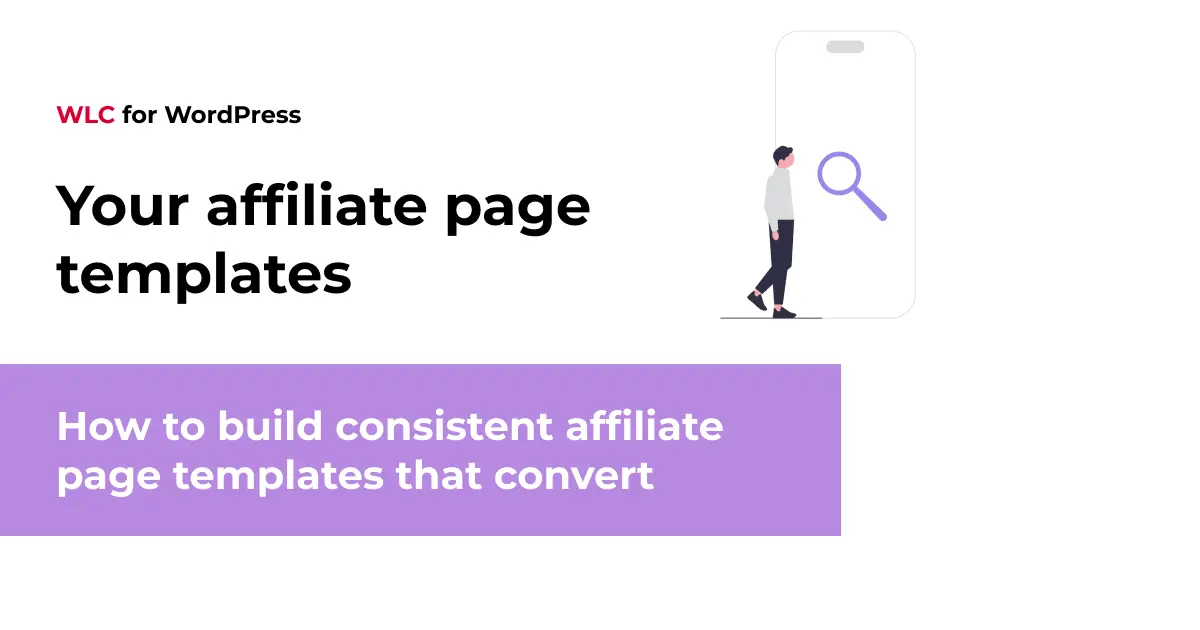Category: WordPress
How to build consistent affiliate page templates that convert

Building affiliate page templates that actually convert isn’t just about making things look pretty. It’s about creating a system that consistently guides visitors toward taking action, whether that’s signing up for a casino account or claiming a bonus. When your templates work properly, they reduce bounce rates, increase conversions, and make your content team’s life much easier.
The problem is that most affiliate sites end up with a patchwork of different page designs, inconsistent messaging, and confusing user experiences. This confusion costs you money every single day. You need a template system that works across all your pages, maintains consistency, and actually drives results.
This guide walks you through building affiliate page templates that convert reliably. You’ll learn why consistency matters so much, what elements make pages actually work, how to build a scalable template system, and how to test and optimise everything for better performance.
Why inconsistent affiliate pages kill your conversion rates
Inconsistent affiliate website design creates immediate trust issues with your visitors. When someone clicks from your casino comparison page to a detailed review, and the layout completely changes, they notice. The navigation moves, the colour scheme shifts, and suddenly they’re questioning whether they’re still on the same site.
This confusion hits your conversion rates hard. Visitors who can’t predict where to find information or how to complete actions simply leave. They don’t have time to figure out a new interface on every page they visit.
Common inconsistency problems include different button styles across pages, varying information layouts for similar content, and mixed messaging about the same operators or bonuses. One page might emphasise welcome bonuses whilst another focuses on loyalty programmes for the same casino. This mixed messaging makes visitors wonder which information they should trust.
The technical side matters too. When different pages load at different speeds or display poorly on mobile devices, you’re creating friction at every step. Some pages might have proper schema markup for search engines whilst others don’t, leading to inconsistent search result appearances.
Your content team feels this pain as well. Without consistent affiliate marketing templates, they spend extra time figuring out how to format each new page. They make different decisions about where to place calls-to-action or how to structure bonus information, leading to more inconsistency.
What makes affiliate page templates actually convert
Converting affiliate pages start with clear value propositions that visitors understand immediately. Your template needs to communicate what the visitor gets and why they should care within the first few seconds. This means prominent headlines, benefit-focused copy, and obvious next steps.
Trust signals are absolutely important for affiliate marketing success. Your templates should consistently include operator licensing information, security badges, and clear terms and conditions. Visitors need to feel confident about the sites you’re recommending, and your template design should reinforce that confidence.
Call-to-action placement makes or breaks page template conversion rates. The most effective affiliate templates position primary actions above the fold and repeat them strategically throughout longer content. Your buttons should use consistent language and styling, so visitors always know what to expect when they click.
Mobile responsiveness isn’t optional anymore. Your templates must work perfectly on phones and tablets, with touch-friendly buttons and readable text. Many affiliate visitors browse on mobile devices, especially when checking bonuses or comparing odds quickly. Implementing responsive web design ensures your templates adapt seamlessly to any screen size.
Page loading speed directly impacts conversion rates. Your templates should be optimised for fast loading, with compressed images, efficient code, and proper caching. Slow pages lose visitors before they even see your content.
Psychological triggers that work well in affiliate templates include scarcity elements for limited-time bonuses, social proof through user ratings, and clear benefit statements that address visitor concerns. Your template should make it easy to include these elements consistently across all pages.
Building your template system for maximum consistency
Start by creating a component library that covers all the elements you use regularly. This includes different types of bonus displays, operator comparison tables, review sections, and call-to-action buttons. Each component should have clear guidelines for when and how to use it.
Your design system needs to define colours, fonts, spacing, and button styles that work across all your affiliate landing pages. Document these decisions so anyone on your team can create pages that look and feel consistent with your brand. Following design preparation best practices ensures your templates translate perfectly from concept to implementation.
Content standardisation matters as much as visual consistency. Create templates for how you present bonus information, review criteria, and operator details. This helps visitors find information quickly and builds trust through predictability.
Technical implementation should focus on flexibility within constraints. Your templates need to handle different content lengths, varying numbers of bonuses or operators, and different types of calls-to-action whilst maintaining consistent structure.
Modern content management approaches can help significantly here. Block-based editing systems allow your content team to build pages using pre-designed components without needing developer involvement. This speeds up page creation whilst maintaining design consistency. Reusable blocks for WordPress sites offer an excellent foundation for building scalable template systems.
Database centralisation solves many consistency problems. When bonus information, operator details, and review data come from a single source, updates appear everywhere automatically. Your templates should be designed to pull from centralised data rather than requiring manual updates on each page.
Version control for your templates prevents inconsistencies from creeping in over time. When you improve a template, those improvements should roll out across all pages using that template, not just new ones.
Testing and optimising your affiliate page templates
Template performance measurement starts with tracking the right metrics. Conversion rate is obviously important, but you also need to monitor bounce rate, time on page, and scroll depth to understand how visitors interact with your templates.
A/B testing different template elements reveals what actually drives better performance. Test button colours, headline variations, and call-to-action placement systematically. Change one element at a time so you can identify what makes the difference.
Heat mapping tools show you where visitors click and how far they scroll on your templates. This data helps you optimise element placement and identify areas where visitors lose interest.
Page speed testing should be part of your regular optimisation routine. Your templates might perform well initially but slow down as you add more content or features. Regular testing catches these issues before they hurt conversions. Understanding Core Web Vitals helps you optimise templates for both user experience and search engine performance.
Mobile-specific testing is particularly important for affiliate sites. Your templates might work perfectly on desktop but have usability issues on phones. Test thoroughly on different devices and screen sizes.
Conversion funnel analysis helps you understand where visitors drop off in your templates. If people view bonus information but don’t click through to operators, you might need to adjust how you present that information or where you place your calls-to-action.
Regular template audits catch inconsistencies that develop over time. Even with good systems, small variations creep in as team members make quick updates or work around technical limitations.
Implementing a solid page template strategy takes time and effort upfront, but it pays off through higher conversion rates, faster content creation, and better user experience. Your templates become a competitive advantage that makes your entire affiliate operation more effective.
When you’re ready to build affiliate page templates that actually convert, consider working with specialists who understand both the technical requirements and the affiliate marketing landscape. Working with a white label agency can provide the expertise needed to create template systems that drive results whilst making content management easier for your team.






